numos
Hazard to Others
  
Posts: 269
Registered: 22-2-2014
Location: Pasadena
Member Is Offline
Mood: No Mood
|
|
The mingling of Palladium and Arsenic
Dichlorobis(triphenylphosphine)palladium is a very common precatalyst in cross coupling reactions. Being a Pd(II) species, it's a relatively air
stable and inexpensive form of Palladium. I recently set out to make the triphenylarsine version. While the Pd-As bond is not nearly as strong,
causing faster catalyst initiation, it also means that the AsPh3 cannot stabilize Pd0 intermediates as well, ultimately causing
faster decomposition. That coupled with Arsenic's toxicity means this complex is really just a nice collector's item.
I made triphenylarsine from arsenic trichloride, which I've made recently here. Some people expressed concern about AsCl3 not being easy to access at home. There is limited literature precedent that
AsI3 can be used as a substitute for AsCl3 in this reaction, although the exact reaction is not reported. I've also included a
quick prep for AsI3 in case someone wants to attempt this route.
Triphenylarsine
To a 100 mL schlenk flask under Ar was added arsenic trichloride (2.5 g, 1 equiv) and a stir bar. Dry THF (20 mL) was added via syringe. The chloride
quickly dissolved giving a homogenous solution. Phenylmagnesium chloride (3.3 equiv, 2M in THF) was added dropwise over 20 minutes. There is a notable
exotherm in this reaction which I saw as a good sign. After the addition was complete, I was left with a clear brown solution. I heated this to 50 oC
overnight resulting in a thick precipitate (likely MgCl2).
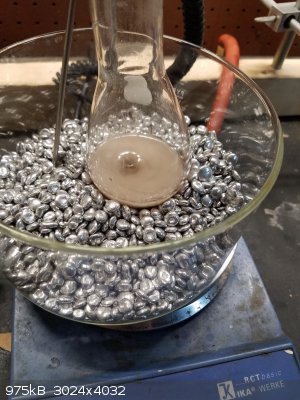
This was left to cool to RT and water (30 mL) was added. This was extracted twice with ether (15 mL) and the combined organics dried over
MgSO4. The solution was concentrated under reduced pressure to yield an off white oil. A small amount of ether (1-2 mL) was added and the
solution left overnight. I was kind of disappointed not to see any crystals. Luckily, the oldest trick in the book, scratching with a glass stir rod
and waiting a few hours afforded these beautiful clear crystals. These were rinsed with a few mL of hexanes several times, and left to dry on a piece
of filter paper yielding 2.2 g of crystals (52%).
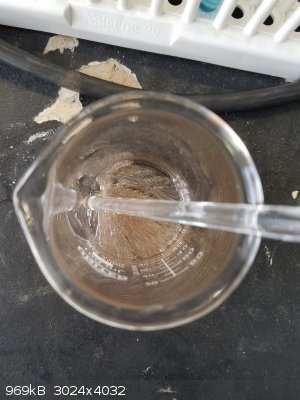 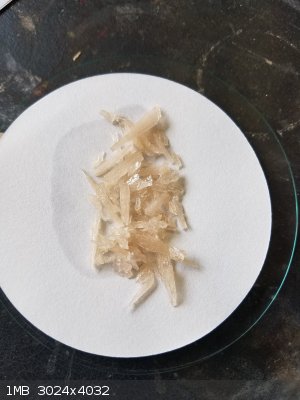
Arsenic triiodide
In a test tube was placed 1 g KI (6 equiv) which was dissolved in 1 mL water. In another test tube with stir bar was added arsenic trioxide (0.2g, 1
equiv). Concentrated aq HCl (2.9 mL) was added and the tube was gently heated with stirring to dissolve everything resulting in a yellowish solution.
This took about 5 minutes at 40 oC. The KI solution was quickly poured into the arsenic solution with stirring resulting in a thick orange
precipitate. The precipitate was left for 5 minutes and filtered. Rising with water causes immediate hydrolysis. So the solid was left on the frit for
a few minutes and then dried under vacuum.
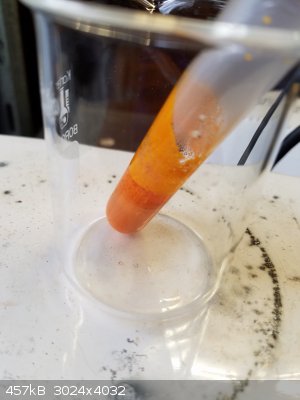 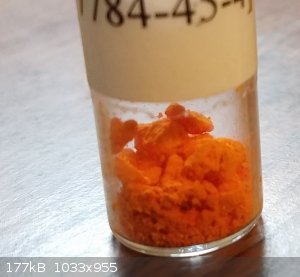
Potassium tetrachloropalladate
Palladium (II) chloride (1 equiv) and potassium chloride (4 equiv) are dissolved in the minimum amount of boiling water resulting in a homogenous
brown solution. Upon cooling the title compound crystallized out as beautiful green-red crystals which are filtered and dried under vacuum. Yields are
almost quantitative.
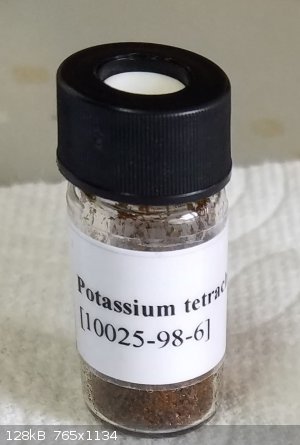
Dichlorobis(triphenylarsine) palladium (II)
Potassium tetrachloropalladate (100 mg, 1 equiv) was placed in a test tube and dissolved in 1.5 mL water. In another test tube, triphenylarsine (187
mg, 2 equiv) was dissolved in 1.5 mL EtOH. Gentle heating was necessary to dissolve both compounds. The solutions are mixed and stirred for 5 minutes
resulting in a dense yellow precipitate. The color is identical to what you would expect for the analogous triphenylphosphine complex. The compound is
filtered, rinsed with water, EtOH, ether, and dried under reduced pressure. The yield is 220 mg (90%)
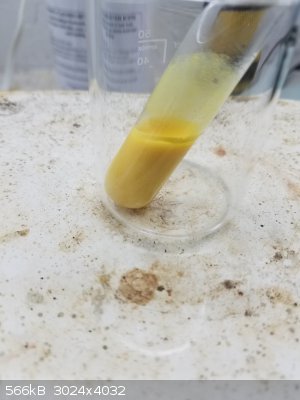 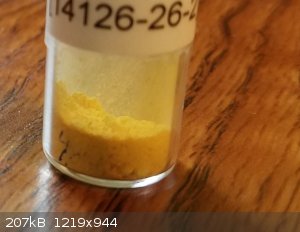
I think this concludes my adventures with Arsenic. Some really pretty chemistry but that's about the extent I'm willing to go. Keep in mind that toxic
arsine gas could be produced at any of these steps and many arsenic compounds are absorbed through skin. Gloves and good ventilation are key to these
reactions. In any case, I hope the pictures are at least nice to look at!
References:
AsPh3: adapted from Org. Synth. 1950, 30, 95
AsI3: Reproduced from Inorg. Synth. V1, 103
K2PdCl4: adapted from Inorg. Chem. 1985, 24, 1503
Pd(AsPh3)2Cl2: Reproduced from Inorg. Chem. 1965, 3, 1587 (Also a very important paper)
|
|
|
numos
Hazard to Others
  
Posts: 269
Registered: 22-2-2014
Location: Pasadena
Member Is Offline
Mood: No Mood
|
|
Also, I know a few of you have asked to see my schlenk setup. I'm working on putting that together in the near future 
|
|
|
reactofurnace
Hazard to Self
 
Posts: 76
Registered: 17-7-2015
Member Is Offline
Mood: Volatile
|
|
Nice! Beautiful colored compounds and large crystals are the best
|
|
|
woelen
Super Administrator
        
Posts: 7977
Registered: 20-8-2005
Location: Netherlands
Member Is Offline
Mood: interested
|
|
Very interesting stuff. The preparation and use of AsCl3 is well beyond my confidence level, but the use of As2O3 to make some AsI3 is something,
which I could try.
|
|
|
Tsjerk
International Hazard
    
Posts: 3022
Registered: 20-4-2005
Location: Netherlands
Member Is Offline
Mood: Mood
|
|
Nice write up! I'm not going to try any of this but it is always nice to see posts like this.
|
|
|
Metacelsus
International Hazard
    
Posts: 2531
Registered: 26-12-2012
Location: Boston, MA
Member Is Offline
Mood: Double, double, toil and trouble
|
|
Another excellent experiment and writeup!
Quote: Originally posted by numos  | Also, I know a few of you have asked to see my schlenk setup. I'm working on putting that together in the near future  |
Yay! I'm excited to see it
|
|
|
DraconicAcid
International Hazard
    
Posts: 4278
Registered: 1-2-2013
Location: The tiniest college campus ever....
Member Is Offline
Mood: Semi-victorious.
|
|
Very nice!
Some days I miss working with such metal complexes (I worked with phosphine complexes of rhodium and iridium). Then I remember what grad studies was
like and I go back to puttering with simple coordination complexes.
Please remember: "Filtrate" is not a verb.
Write up your lab reports the way your instructor wants them, not the way your ex-instructor wants them.
|
|
|
Heptylene
Hazard to Others
  
Posts: 319
Registered: 22-10-2016
Member Is Offline
Mood: No Mood
|
|
Nice chemistry! And very pretty colors, especially that arsenic triiodide! I'll have to try to make some one day.
Btw is that tin shot in your heating bath? Does it work well to heat flasks?
|
|
|
numos
Hazard to Others
  
Posts: 269
Registered: 22-2-2014
Location: Pasadena
Member Is Offline
Mood: No Mood
|
|
Glad to hear it, I had you in mind when I was making this one 
I believe it's aluminum shot. It functions kind of like a sand bath but has pros and cons. The biggest pro is it's very clean and doesn't foul over
time. Unlike sand it doesn't cover everything with sand and pose risk to scratching ground glass joints. It also heats up much faster, I would say
even faster than an oil bath which is nice.
Downside is that you can't push a flask into it and expect it to move out of the way. You always have to put your flask in first and then pour this
over it - which is hard to do when it's hot. Frankly not a huge deal but sometime I want to take my flask out to check and then stare dishearteningly
as my little flask tunnel collapses.
|
|
|
Justin Blaise
Hazard to Self
 
Posts: 82
Registered: 5-10-2011
Location: Parts Unknown
Member Is Offline
Mood: No Mood
|
|
Really nice work! Do you plan on making other transition metal complexes with your AsPh3? Maybe some Co or Ni complexes?
|
|
|
numos
Hazard to Others
  
Posts: 269
Registered: 22-2-2014
Location: Pasadena
Member Is Offline
Mood: No Mood
|
|
Probably not anytime soon. I wanted to make the Pd complex because I've used the PPh3 analog for coupling reactions, so it has nostalgic value. Lots
of other things planned though, don't worry!
|
|
|